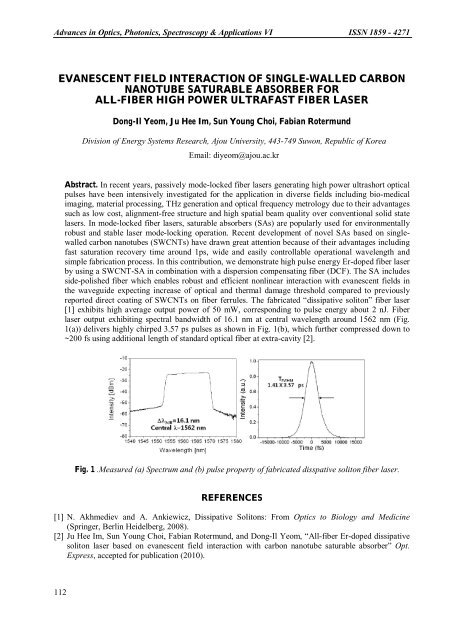Nhng tin b trong Quang hc, Quang ph và ng dng VI ISSN 1859 - 4271
Nhng tin b trong Quang hc, Quang ph và ng dng VI ISSN 1859 - 4271
Nhng tin b trong Quang hc, Quang ph và ng dng VI ISSN 1859 - 4271
You also want an ePaper? Increase the reach of your titles
YUMPU automatically turns print PDFs into web optimized ePapers that Google loves.
Advances in Optics, Photonics, Spectroscopy & Applications <strong>VI</strong> <strong>ISSN</strong> <strong>1859</strong> - <strong>4271</strong>EVANESCENT FIELD INTERACTION OF SINGLE-WALLED CARBONNANOTUBE SATURABLE ABSORBER FORALL-FIBER HIGH POWER ULTRAFAST FIBER LASERDo<strong>ng</strong>-Il Yeom, Ju Hee Im, Sun You<strong>ng</strong> Choi, Fabian RotermundDivision of Energy Systems Research, Ajou University, 443-749 Suwon, Republic of KoreaEmail: diyeom@ajou.ac.krAbstract. In recent years, passively mode-locked fiber lasers genera<s<stro<strong>ng</strong>>tro<strong>ng</strong></stro<strong>ng</strong>>>tin</s<stro<strong>ng</strong>>tro<strong>ng</strong></stro<strong>ng</strong>>>g high power ultrashort opticalpulses have been intensively investigated for the application in diverse fields includi<strong>ng</strong> bio-medicalimagi<strong>ng</strong>, material processi<strong>ng</strong>, THz generation and optical frequency metrology due to their advantagessuch as low cost, alignment-free structure and high spatial beam quality over conventional solid statelasers. In mode-locked fiber lasers, saturable absorbers (SAs) are popularly used for environmentallyrobust and stable laser mode-locki<strong>ng</strong> operation. Recent development of novel SAs based on si<strong>ng</strong>lewalledcarbon nanotubes (SWCNTs) have drawn great attention because of their advantages includi<strong>ng</strong>fast saturation recovery time around 1ps, wide and easily controllable operational wavele<strong>ng</strong>th andsimple fabrication process. In this contribution, we demonstrate high pulse energy Er-doped fiber laserby usi<strong>ng</strong> a SWCNT-SA in combination with a dispersion compensa<s<stro<strong>ng</strong>>tro<strong>ng</strong></stro<strong>ng</strong>>>tin</s<stro<strong>ng</strong>>tro<strong>ng</strong></stro<strong>ng</strong>>>g fiber (DCF). The SA includesside-polished fiber which enables robust and efficient nonlinear interaction with evanescent fields inthe waveguide expec<s<stro<strong>ng</strong>>tro<strong>ng</strong></stro<strong>ng</strong>>>tin</s<stro<strong>ng</strong>>tro<strong>ng</strong></stro<strong>ng</strong>>>g increase of optical and thermal damage threshold compared to previouslyreported direct coa<s<stro<strong>ng</strong>>tro<strong>ng</strong></stro<strong>ng</strong>>>tin</s<stro<strong>ng</strong>>tro<strong>ng</strong></stro<strong>ng</strong>>>g of SWCNTs on fiber ferrules. The fabricated “dissipative soliton” fiber laser[1] exhibits high average output power of 50 mW, correspondi<strong>ng</strong> to pulse energy about 2 nJ. Fiberlaser output exhibi<s<stro<strong>ng</strong>>tro<strong>ng</strong></stro<strong>ng</strong>>>tin</s<stro<strong>ng</strong>>tro<strong>ng</strong></stro<strong>ng</strong>>>g spectral bandwidth of 16.1 nm at central wavele<strong>ng</strong>th around 1562 nm (Fig.1(a)) delivers highly chirped 3.57 ps pulses as shown in Fig. 1(b), which further compressed down to~200 fs usi<strong>ng</strong> additional le<strong>ng</strong>th of standard optical fiber at extra-cavity [2].Fig. 1 .Measured (a) Spectrum and (b) pulse property of fabricated disspative soliton fiber laser.REFERENCES[1] N. Akhmediev and A. Ankiewicz, Dissipative Solitons: From Optics to Biology and Medicine(Spri<strong>ng</strong>er, Berlin Heidelberg, 2008).[2] Ju Hee Im, Sun You<strong>ng</strong> Choi, Fabian Rotermund, and Do<strong>ng</strong>-Il Yeom, “All-fiber Er-doped dissipativesoliton laser based on evanescent field interaction with carbon nanotube saturable absorber” Opt.Express, accepted for publication (2010).112















